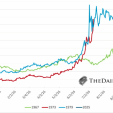What Drives The Price Of Gold & Silver
If there is a credible rumor that the Fed is planning to further extend its “Quantitative Easing”, how would you expect the monetary metals to react? Typically, the gold price would rise and the silver price would rise even more. The question is why.
Traders read the headlines and they know how the price “should” react to such news, and they begin buying. For a while, the prophecy fulfills itself. But then what happens next? It may take an hour or a month, but sooner or later some of the new buyers begin to sell. What can be bought on speculation using leverage must eventually be sold. Traders who buy gold and silver futures think of their “profits” measured in dollars. They cannot profit from the rising gold price until they sell. So, sooner or later, they must sell. Alternatively, if the price goes down, they must sell because they are incurring losses at a multiple of the price drop due to their use of leverage.
Nearly all buyers of futures are speculators. They could be called “naked longs” because they have neither the intent nor the means to take delivery. Their predictable behavior when a particular contract heads into expiry has a characteristic behavior. One can see this in the gold and silver bases.
One way to debunk the “naked short seller” conspiracy theory is to watch the basis heading into First Notice Day. Naked longs must sell the expiring contract, and if they wish to remain long the metal, they must buy another farther-out contract. Right now, for example, we are in the late stages of “rolling” from the March silver contract to May (there were about 80,000 contracts open a month ago, and now about 30K).
Anyway, getting back to the topic, speculators are frequently driving up the price by buying news and rumors and almost as often driving down the price. In the short run, they can have an enormous impact on the price. But in the long run, they have almost none.
There are an estimated seven billion people on Earth. Most of them don’t read about the US stock market, the press releases from the Governor of the Bank of England, or the latest politics surrounding the appointment of a new head at the Bank of Japan. They don’t know how the price is supposed to move when earnings estimates for the S&P 500 are raised or lowered.
They are doing one of two things with physical metal. They are either slowly hoarding it, as the only safe store of wealth they can understand. Or they are performing arbitrage, each with his notion of the “right price”. When metal is priced lower than their threshold, these latter folks buy. When the price rises above, they sell. Most of them, of course, don’t even look at the price measured in dollars. They are using another currency, such as rupees.
The actions of the hoarders will sooner enough cause the final descent into permanent gold backwardation. But don’t count your paper “profits” just yet. This is not a time when gold owners get “rich”. Sure, the gold will have a high value indeed, though it may be worth your life to show anyone that you have it as occurred throughout history.
Permanent gold backwardation—the withdrawal of the gold bid on the dollar—will lead to bad times ( https://www.gold-eagle.com/editorials_12/weiner022912.html ). Certainly, government policies are causing the capital base that supports our society to be hollowed out. If it can no longer support us, if the debt-based currencies no longer work, and if industries such as food distribution seize up due to lack of credit, then even the best case is pretty bleak.
For now, the actions of the arbitragers drive the price. Gold and silver are totally unlike any other commodities. Both metals have a stocks to flows ratio that is extraordinarily high. Stocks to flows is total global inventories divided by annual mine production. For gold and silver, this number is in the many decades. For other commodities, it’s measured in months.
All of this inventory is potential supply at the right price. If the price rises above the threshold set by a large number of owners, then metal comes into the market. If the price falls below this threshold (or the threshold ratchets up) then metal is taken out of the market.
The speculators can drive the price quite far in either direction, in the short term. But it is the hoarders and arbitrageurs who drive the price in the long term. A century ago, gold was worth about $20 an ounce. Now it is worth about $1600. This is another way of saying that the dollar has gone down to 1/80th its value. This trend is not going to end soon (or indeed end at all). But it does not move in a straight line, as these past few years have proven once again.
Wouldn’t it be nice to have an indicator that can help one determine whether hoarders and arbitrageurs are driving the price at the moment, or if it’s just the speculators again? This is precisely what the basis shows (among other things). In other words, are you buying your physical gold or silver into a speculative move (bad), or are your purchases part of fundamentals-driven move (good)?






 Dr. Keith Weiner is the CEO of Monetary Metals and the president of the Gold Standard Institute USA. Keith is a leading authority in the areas of gold, money, and credit and has made important contributions to the development of trading techniques founded upon the analysis of bid-ask spreads. Keith is a sought after speaker and regularly writes on economics. He is an Objectivist, and has his PhD from the New Austrian School of Economics. His website is
Dr. Keith Weiner is the CEO of Monetary Metals and the president of the Gold Standard Institute USA. Keith is a leading authority in the areas of gold, money, and credit and has made important contributions to the development of trading techniques founded upon the analysis of bid-ask spreads. Keith is a sought after speaker and regularly writes on economics. He is an Objectivist, and has his PhD from the New Austrian School of Economics. His website is 










